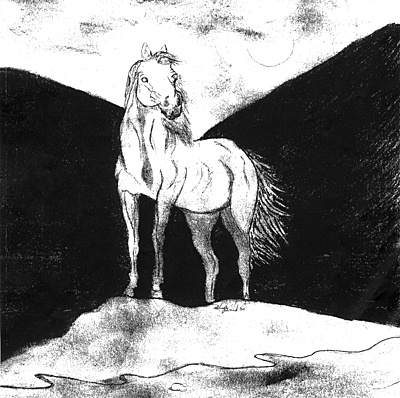All Nonfiction
- Bullying
- Books
- Academic
- Author Interviews
- Celebrity interviews
- College Articles
- College Essays
- Educator of the Year
- Heroes
- Interviews
- Memoir
- Personal Experience
- Sports
- Travel & Culture
All Opinions
- Bullying
- Current Events / Politics
- Discrimination
- Drugs / Alcohol / Smoking
- Entertainment / Celebrities
- Environment
- Love / Relationships
- Movies / Music / TV
- Pop Culture / Trends
- School / College
- Social Issues / Civics
- Spirituality / Religion
- Sports / Hobbies
All Hot Topics
- Bullying
- Community Service
- Environment
- Health
- Letters to the Editor
- Pride & Prejudice
- What Matters
- Back
Summer Guide
- Program Links
- Program Reviews
- Back
College Guide
- College Links
- College Reviews
- College Essays
- College Articles
- Back
Mustangs: Living Legends MAG
The shallow rasp of breath, the pounding of hooves, manes flying with the wind,muscles rippling with each movement ... mustangs are the ultimate symbol of theAmerican frontier. But the truth is, they are going the way of the frontier. Youmight ask, so what? Who needs another useless animal roaming around?
Well,mustangs aren't just another animal, and they certainly aren't useless. They arewild horses of Mexico, the western plains of the United States, and parts ofwestern Canada. They were originally brought to North America by Spanishexplorers in the late 15th century. These small but sturdy horses were relishedfor their remarkable endurance and intelligence, and highly valued as saddlehorses. Some escaped and became feral.
Throughout the years, ranchers -and the government on their behalf - have used every possible means toexterminate mustangs: poisoning their watering holes and blinding lead stallionsby shooting their eyes out to make the capture of an entire herd easier, as wellas running them over cliffs to their deaths, slaughtering them for pet food andshooting whole herds. In the 1800s as many as five million mustangs roamed NorthAmerica. Now, there are only about 42,000 still roaming on public lands inArizona, California, Colorado, Idaho, Montana, Nevada, New Mexico, Oregon, Utahand Wyoming (http://wildhorserescue.org/history.html).
Progress hasreduced the mustang's range, replacing grasslands with farms, ranches, highwaysand cities. The remaining mustangs now run through publicly owned lands orprivate sanctuaries set aside for them, small remnants of the area they oncereigned over.
The Bureau of Land Management (BLM) is now responsiblefor managing the public lands on which mustangs roam. In 1971, the Wild Horse andBurro Act was passed, stating: "Congress finds and declares that wild,free-roaming horses and burros are living symbols of the historic and pioneerspirit of the West; that they contribute to the diversity of lifeforms within thenation and enrich the lives of the American people." This act declaredmustangs and burros to be important to our history, thus putting them under theprotection of the government. The primary responsibilities of the BLM are topreserve and protect mustangs and burros and to manage healthy rangelands. Whenan overpopulation of mustangs (or burros) exists on the range, the excess animalsare removed and placed in the large, if somewhat controversial, adoption
program.
Though the mustang's dilemma is significant, there aremany possible solutions without resorting to violence or death, including birthcontrol, adoption and providing some kind of sanctuary. Birth control vaccinesare being developed and perfected, so rather than increase the death rate, whynot decrease the birth rate?
In sanctuaries, mustangs are allowedfreedom. It's just like being on an open plain, only they are protected. Themustangs often share space with other wildlife, too.
Adoption, though lessexpensive and more practical, is controversial. If placed in the right home, amustang can live a life of luxury. Put in the wrong hands, a mustang can be on adead-end road. After a year-long waiting period, owners-to-be acquire titles forthe mustangs and can do whatever they please with them. Many adopted mustangs endup in slaughter houses, their owners receiving up to $700 for their $125investment.
Several horse protection agencies are working against thehorsemeat industry. They wish to pass a law that makes sending a horse toslaughter a felony. They're not quite there yet, but they've already passed a lawprohibiting horses' transportation to slaughter on double-decker cattletrailers.
Man has accomplished much in partnership with these creatures ofbeauty and grace. We owe them the little freedom we can provide and reassurancethat this freedom will always be there. It is our duty to provide for andpreserve the magnificent mustang.

Similar Articles
JOIN THE DISCUSSION
This article has 1 comment.

0 articles 0 photos 12292 comments